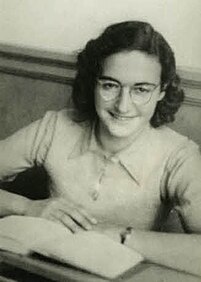 W
WFriedrich Adler was a German artist, designer and academic. He was renowned for his accomplishments in designing metalwork in the Art Nouveau and Art deco styles; he was also the first designer to use bakelite. He designed using a wide variety of objects and materials.
 W
WBernhard Bästlein was a German Communist and resistance fighter against the Nazi régime. He was imprisoned very shortly after the Nazis seized power in 1933 and was imprisoned almost without interruption until his execution in 1944, by the Nazis. Nonetheless, he was one of the most important leaders of German Resistance.
 W
WGertrud Cohn was a German victim of the Nazi regime. The fate of her family was published as a children's book. The book became the basis for an exhibition, a play and a film. The book is used in German primary schools for children between ten and twelve.
 W
WMargot Betti Frank was the elder daughter of Otto Frank and Edith Frank and the elder sister of Anne Frank. Margot's deportation order from the Gestapo hastened the Frank family into hiding. According to the diary of her younger sister, Anne, Margot kept a diary of her own, but no trace of Margot's diary has ever been found. She died in Bergen-Belsen concentration camp.
 W
WElse Hirsch was a Jewish teacher in Bochum, Germany, and a member of the German Resistance against the Third Reich. She organized transports of Jewish children to the Netherlands and England, saving them from Nazi deportation to concentration camps and death. Hirsch perished in the Riga Ghetto, at the age of 53 or 54.
 W
WFranz Jägerstätter was an Austrian conscientious objector during World War II. Jägerstätter was sentenced to death and executed for his refusal to fight for Nazi Germany. He was later declared a martyr and beatified by the Catholic Church.
 W
WKarlrobert Kreiten was a German pianist, though holding Dutch citizenship his entire life due to his Dutch father.
 W
WIngeborg Kummerow was a Berlin office worker and housewife who in 1936 had married Dr. Hansheinrich Kummerow, a high-flying telecommunications engineer, employed in the research and development department at Loewe-Radio-AG. Loewe was an electronics company which had taken a lead in developing televisions technology, but which was by this time increasingly concentrating on defence related telecommunications technology. It was through her husband that Ingeborg Kummerow became involved in anti-government resistance. She was one of a batch of seventeen execution victims who died on the guillotine at the Plötzensee execution facility on 5 August 1943. Sources giving the date of her execution, incorrectly, as 5 August 1944 are believed to be based on a self-perpetuating error.
 W
WThe Stolpersteine in the Lake Constance district lists all Stolpersteine that have been collocated in Friedrichshafen and Überlingen in the Bodenseekreis in the very South of Germany. Stolpersteine is the German name for stumbling blocks collocated all over Europe by German artist Gunter Demnig. They remember the fate of the Nazi victims being murdered, deported, exiled or driven to suicide.
 W
WHilde Meisel was a Jewish German socialist and journalist who published articles against the Nazi regime in Germany. While in exile in England, she wrote under the pseudonym Hilda Monte, calling for German resistance to Nazism in magazines, books and in radio broadcasts. She acted as a courier and repeatedly undertook secret operations in Germany, Austria, France and Portugal, although as a social democrat and Jew, it was extremely dangerous for her to do so. Other code names she used in exile were Hilde Olday, Selma Trier, Helen Harriman, Eva Schneider, H. Monte, Hilda Monte and Hilde Monte.
 W
WRobert Erich Remak was a German mathematician. He is chiefly remembered for his work in group theory. His other interests included algebraic number theory, mathematical economics and geometry of numbers. Robert Remak was the son of the neurologist Ernst Julius Remak and the grandson of the embryologist Robert Remak.
 W
WBruno Guido Camillo Tesch was a German communist and member of the Young Communist League of Germany. At age 20, he was convicted of murder and executed in connection with the Altona Bloody Sunday riot, a Sturmabteilung (SA) march on 17 July 1932 that turned violent and led to 18 people being shot and killed. His conviction was overturned in November 1992.
 W
WThe Stolpersteine in Weingarten lists all Stolpersteine that have been collocated in Weingarten in the very south of Germany. Stolpersteine is the German name for stumbling blocks collocated all over Europe by German artist Gunter Demnig. They remember the fate of the Nazi victims being murdered, deported, exiled or driven to suicide.